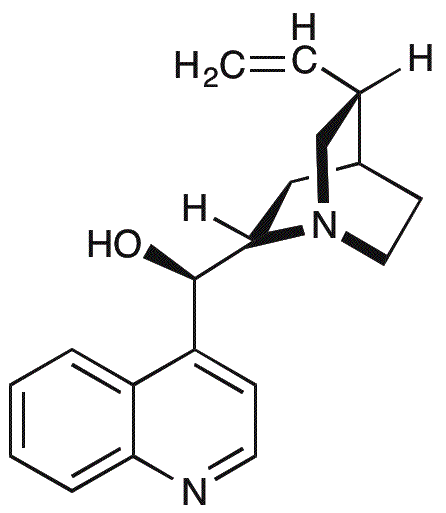Cinchonidine is widely utilized in research focused on:
- Pharmaceutical Development: It serves as a key intermediate in the synthesis of various alkaloids and pharmaceuticals, particularly in the development of anti-malarial drugs.
- Chiral Catalysis: This compound is employed as a chiral ligand in asymmetric synthesis, enhancing the production of enantiomerically pure compounds, which is crucial in the pharmaceutical industry.
- Analytical Chemistry: Cinchonidine is used in chromatography as a chiral stationary phase, allowing for the separation and analysis of enantiomers in complex mixtures.
- Natural Product Synthesis: It plays a significant role in the synthesis of complex natural products, aiding researchers in the study of bioactive compounds derived from natural sources.
- Research in Neuroscience: Its properties are investigated for potential applications in neuropharmacology, particularly in understanding its effects on neurotransmitter systems.
General Information
Properties
Safety and Regulations
Applications
Cinchonidine is widely utilized in research focused on:
- Pharmaceutical Development: It serves as a key intermediate in the synthesis of various alkaloids and pharmaceuticals, particularly in the development of anti-malarial drugs.
- Chiral Catalysis: This compound is employed as a chiral ligand in asymmetric synthesis, enhancing the production of enantiomerically pure compounds, which is crucial in the pharmaceutical industry.
- Analytical Chemistry: Cinchonidine is used in chromatography as a chiral stationary phase, allowing for the separation and analysis of enantiomers in complex mixtures.
- Natural Product Synthesis: It plays a significant role in the synthesis of complex natural products, aiding researchers in the study of bioactive compounds derived from natural sources.
- Research in Neuroscience: Its properties are investigated for potential applications in neuropharmacology, particularly in understanding its effects on neurotransmitter systems.
Documents
Safety Data Sheets (SDS)
The SDS provides comprehensive safety information on handling, storage, and disposal of the product.
Product Specification (PS)
The PS provides a comprehensive breakdown of the product’s properties, including chemical composition, physical state, purity, and storage requirements. It also details acceptable quality ranges and the product's intended applications.
Certificates of Analysis (COA)
Search for Certificates of Analysis (COA) by entering the products Lot Number. Lot and Batch Numbers can be found on a product’s label following the words ‘Lot’ or ‘Batch’.
*Catalog Number
*Lot Number
Certificates Of Origin (COO)
This COO confirms the country where the product was manufactured, and also details the materials and components used in it and whether it is derived from natural, synthetic, or other specific sources. This certificate may be required for customs, trade, and regulatory compliance.
*Catalog Number
*Lot Number
Safety Data Sheets (SDS)
The SDS provides comprehensive safety information on handling, storage, and disposal of the product.
DownloadProduct Specification (PS)
The PS provides a comprehensive breakdown of the product’s properties, including chemical composition, physical state, purity, and storage requirements. It also details acceptable quality ranges and the product's intended applications.
DownloadCertificates of Analysis (COA)
Search for Certificates of Analysis (COA) by entering the products Lot Number. Lot and Batch Numbers can be found on a product’s label following the words ‘Lot’ or ‘Batch’.
*Catalog Number
*Lot Number
Certificates Of Origin (COO)
This COO confirms the country where the product was manufactured, and also details the materials and components used in it and whether it is derived from natural, synthetic, or other specific sources. This certificate may be required for customs, trade, and regulatory compliance.


